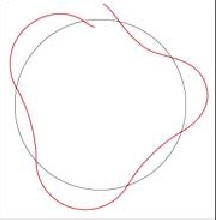Mikrowelt: Bose-Einstein-Kondensat/Photonenstatistik
An extension of the Bohr-Sommerfeld quantum condition ...

... as Einstein describes it at first in his 1917 paper, allows for such oscillations - to use again the later wave picture - which need more than one revolution in order to result in a closed wavetrain. They are thus characterized by two integer numbers - that of the periods and that of the revolutions. According to Einstein's sketch of the principle and to present-day terminology, this is a torus quantization, also termed Einstein-Brillouin-Keller (EBK) quantization.
At the same time, he works out the apparently small but decisive distinction to such electronic orbits which arbitrarily often and arbitrarily close return to every point, but never really close. This type of motion (which Keller does not consider at first) corresponds to a fundamental assumption of classical statistical mechanics (ergodic hypothesis), i.e. is a model view of the complex motion of classical many-particle systems (or of Bohr's atomic model with many electrons alike) - which are not comprised by the EBK quantization rule.
[ Sitemap ]
[ info ] This website was created by the MPI for the History of Science.
 Scene
Scene


 1st Slide
1st Slide
 Branching Point
Branching Point
 Module: Mikrowelt: Bose-Einstein-Kondensat/Photonenstatistik
Module: Mikrowelt: Bose-Einstein-Kondensat/Photonenstatistik Sequence: lev0_start
Sequence: lev0_start Branching Point: Particles and Light under Control
Branching Point: Particles and Light under Control Slide: Functional Principle of the Paul Trap
Slide: Functional Principle of the Paul Trap Back
Back

